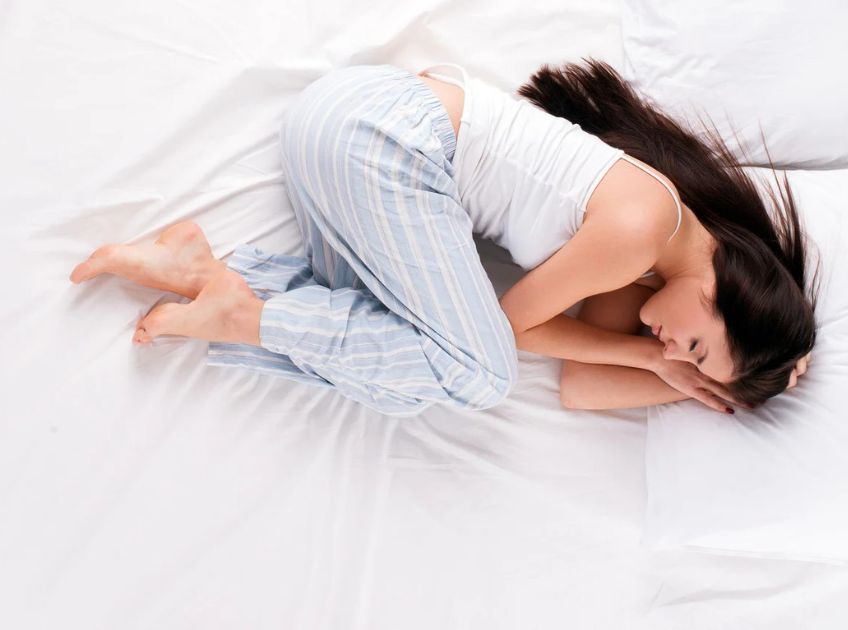
Important: This article is for informational purposes only. Please read our full disclaimer for more details.
A herniated disc can make even simple activities like sleeping feel like a painful ordeal. The position you sleep in plays a critical role in either soothing or worsening that discomfort. Choosing the right sleep posture can relieve pressure on your spine and help you heal better.
This guide explores how sleep affects a herniated disc, the best positions for relief, and what to avoid. Let’s dive in.
Understanding Herniated Disc and Sleep Strain
A herniated disc—also called a slipped or ruptured disc—occurs when the soft center of a spinal disc pushes through a crack in its outer casing. This may irritate nearby nerves, leading to pain, numbness, or weakness, especially in the back or legs.
When you lie down, the pressure on your spinal discs redistributes. But if your sleeping posture causes misalignment or increases disc pressure, it can worsen inflammation and pain.
Why Sleep Position Matters for Disc Health
Spinal alignment during sleep can either support recovery or contribute to further damage. According to a 2022 review published in the Journal of Clinical Neuroscience, spinal biomechanics during rest play a direct role in pain modulation in disc herniation cases (1)(2). Neutral positioning of the spine reduces compression on the affected disc and surrounding nerves.
Poor sleep posture may also trigger muscle stiffness and prolong inflammation, leading to disrupted rest and slower healing.
Best Sleeping Positions for a Herniated Disc
Sleeping with a herniated disc requires more than just comfort — it demands proper spinal alignment to reduce pressure on the disc and nerves. A poor sleeping position can aggravate pain, while a supportive one can ease discomfort and help the body heal overnight.
Here are the most effective sleeping positions, each tailored to relieve spinal stress and improve sleep quality:
1. On Your Back with a Pillow Under the Knees
This is one of the most recommended positions for people with herniated discs, especially in the lower back.
Why it works
Lying flat on your back distributes weight evenly and keeps the spine aligned. Placing a pillow under your knees slightly elevates the legs, reducing pressure on the lumbar spine by relaxing the hip flexors and supporting the spine’s natural “S” curve.
Tips
- Use a medium-firm mattress to avoid sagging in the lower back.
- Choose a soft, supportive neck pillow to keep the cervical spine aligned.
2. On Your Side with a Pillow Between the Knees
This position is ideal for those who can’t sleep on their back and is especially helpful if the herniated disc is pressing on one side.
Why it works
Side sleeping keeps the spine in a neutral position when paired with a pillow between the knees. This prevents the top leg from twisting the lower spine and hips, reducing rotational stress on the vertebrae.
Tips
- Slightly bend your knees into a fetal-like position to reduce pressure between vertebrae.
- Make sure your head pillow isn’t too high or too low, keeping your neck in line with your spine.
3. In a Reclined Position (Using a Recliner or Adjustable Bed)
Some people find significant relief from sleeping in a semi-upright position.
Why it works
Reclining reduces pressure on the lumbar discs by opening up the angle between the thighs and torso. This position can minimize nerve compression and is especially effective for conditions like isthmic spondylolisthesis or severe herniation in the lower spine.
Tips
- Use a recliner or an adjustable bed to find the most comfortable incline.
- Support your neck and lower back with small cushions or ergonomic pillows.
4. Modified Fetal Position
This variation of side sleeping works particularly well for herniated discs in the lower back.
Why it works
Curling your body into a loose fetal shape opens the space between the vertebrae, especially in the lumbar region. This can relieve nerve root compression and reduce tension in the lower spine.
Tips
- Avoid tucking in too tightly, as it may strain the neck or upper spine.
- Switch sides during the night to prevent muscle imbalances or stiffness.
5. Zero Gravity Position
This posture mimics the body’s natural resting position in space — knees and head slightly elevated.
Why it works
The zero-gravity position evenly distributes weight and reduces pressure on the spine by elevating both the legs and upper body. It helps minimize muscle tension and disk compression, making it ideal for chronic pain sufferers.
Tips
- Use an adjustable bed frame or a wedge pillow set to create this position.
- Keep your arms relaxed at your sides, and avoid propping up your head too high.
Sleeping Positions to Avoid for Herniated Discs
Some positions can worsen disc pain or cause poor spinal alignment:
- Sleeping on the stomach: Forces the spine into an unnatural curve, increasing lumbar pressure and neck strain
- Side sleeping without leg support: Causes pelvic tilt and spinal misalignment
- Back sleeping without knee support: May flatten the lumbar curve and worsen lower back discomfort
These positions can compress the vertebrae and discs, exacerbating inflammation or nerve irritation.
Pillow Tips for Better Support
1. Choose the Right Pillow Height
A pillow that’s too high or too flat can misalign your neck and spine. Your pillow should keep your head in a neutral position, aligned with your spine.
2. Use a Lumbar Support Pillow
If you sleep on your back, placing a small pillow or rolled-up towel under your lower back can provide extra lumbar support and reduce strain.
3. Try a Body Pillow
For side sleepers, hugging a body pillow keeps your shoulders and hips aligned while also reducing rolling during the night.
4. Add a Knee Pillow
If you’re on your back, a pillow under your knees can decrease tension in your lower spine. If you’re on your side, placing one between your knees prevents pelvic rotation.
5. Consider a Cervical Pillow for Neck Support
A contoured cervical pillow can keep your neck aligned with your spine, especially if you tend to wake up with upper back or neck stiffness.
6. Memory Foam for Even Support
Memory foam pillows mold to the shape of your head and neck, offering consistent support without collapsing overnight.
Scientific Backing and Recommendations
A study published in Spine Journal (2019) concluded that optimal sleep posture significantly reduced pain intensity and improved sleep quality in patients with lumbar disc herniation (3).
Additionally, researchers emphasize the importance of sleep hygiene (4), consistent sleep schedules, proper mattress firmness, and ergonomic pillows to support spinal healing and reduce inflammation (5).
Frequently Asked Questions (FAQ’S)
1. Is sleeping on the floor good for herniated discs?
A. While some people find relief sleeping on firmer surfaces, it can be too harsh for those with severe disc herniation. A medium-firm mattress is generally more effective for supporting spinal curves.
2. Should I sleep with or without a pillow if I have a herniated disc?
A. You should use a supportive pillow that maintains neck and spine alignment. A thin pillow is ideal for back sleepers, while side sleepers benefit from thicker, contoured pillows.
3. Can changing my sleep position alone heal a herniated disc?
A. While sleep position helps manage symptoms and supports healing, it should be combined with physical therapy, proper posture during the day, and medical care for complete recovery.
Align Your Sleep for Faster Relief
Your sleeping position has a powerful impact on your spine’s health. By choosing supportive postures like back sleeping with knee support or the fetal position, you can ease pain from a herniated disc and promote better healing. Avoid stomach sleeping and unsupportive positions that strain your spine.















